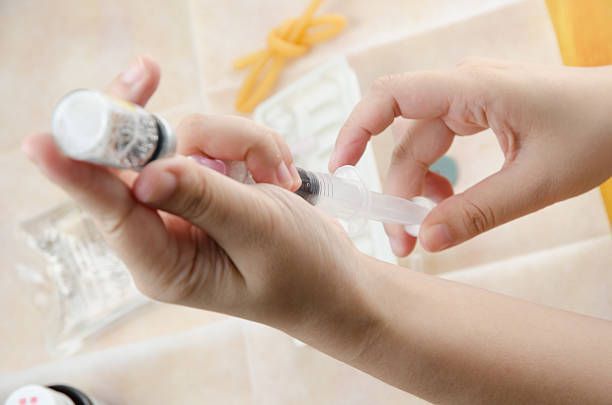IV Therapy for POTS Syndrome: Managing POTS Syndrome with Targeted Treatment

Living with POTS syndrome can be a challenging experience. This condition, which is short for Postural Orthostatic Tachycardia Syndrome, can cause a range of symptoms such as dizziness, fatigue, and heart palpitations.
While there are various treatments available, one promising approach is IV therapy. This targeted treatment involves infusing a customized blend of vitamins, minerals, and other nutrients directly into the bloodstream.
By bypassing the digestive system, IV therapy can deliver a potent dose of healing compounds directly to the cells and tissues that need it most. In this article, we'll explore the benefits of IV therapy for managing POTS syndrome and how it can help unlock the power of targeted treatment.
Whether you're a patient, caregiver, or healthcare provider, you'll discover why IV therapy is becoming an increasingly popular option for those seeking relief from the symptoms of POTS syndrome. So let's dive in and discover the power of IV therapy for managing this complex condition.
Understanding POTS Syndrome
Postural Orthostatic Tachycardia Syndrome (POTS) is a type of dysautonomia that affects the body's autonomic nervous system. The autonomic nervous system controls automatic bodily functions such as heart rate, blood pressure, and digestion.
POTS syndrome is characterized by a significant increase in heart rate upon changing position from lying down to standing up, which can cause symptoms such as dizziness, lightheadedness, and fainting.
Other symptoms of POTS syndrome can include fatigue, brain fog, headaches, and gastrointestinal issues. The exact cause of POTS syndrome is unknown, but it is believed to be related to a malfunction of the autonomic nervous system.
Traditional Treatments for POTS Syndrome
There are several traditional treatments available for POTS syndrome, including lifestyle modifications, medications, and physical therapy. Lifestyle modifications can include increasing salt intake, staying hydrated, and avoiding triggers such as hot temperatures and standing for long periods.
Medications such as beta-blockers, fludrocortisone, and midodrine can also be prescribed to help manage symptoms. Physical therapy can be helpful in improving blood flow and muscle strength, which can reduce symptoms of POTS syndrome. While these treatments can be effective for some people, others may not experience significant relief from their symptoms.

Advantages of IV Therapy for POTS Syndrome
IV therapy is becoming an increasingly popular option for managing POTS syndrome. This targeted treatment involves infusing a customized blend of vitamins, minerals, and other nutrients directly into the bloodstream.
By bypassing the digestive system, IV therapy can deliver a potent dose of healing compounds directly to the cells and tissues that need it most. This can be especially beneficial for those with POTS syndrome, as the condition can affect the digestive system and make it difficult to absorb nutrients from food and supplements.
IV therapy can also provide a more immediate and noticeable improvement in symptoms compared to traditional treatments.
This is because the nutrients are delivered directly to the cells, which can help them more effectively absorb and utilize the compounds.
How IV Therapy Works for POTS Syndrome
IV therapy works by infusing a customized blend of nutrients directly into the bloodstream through a vein in the arm. The specific blend of nutrients can vary depending on the individual's needs and can include vitamins, minerals, amino acids, and antioxidants.
These nutrients can help support the body's natural healing processes and improve overall health and wellbeing. In the case of POTS syndrome, IV therapy can help improve blood flow, reduce inflammation, and support the function of the autonomic nervous system. The effects of IV therapy can last for several days to a week, depending on the individual and the specific blend of nutrients used.
Blood samples can also be taken during IV therapy to measure the body's nutrient levels. This can help the provider identify any deficiencies or imbalances that need to be addressed.
Who Can Benefit from IV Therapy for POTS Syndrome?
IV therapy can be beneficial for anyone who is looking for a more targeted and effective approach to managing their symptoms.
People with Unsuccessful Treatments
One group of individuals who can benefit from IV Therapy for POTS Syndrome are those who have tried other treatments with little success.
Many individuals with POTS Syndrome have tried a variety of medications, lifestyle changes, and other therapies to manage their symptoms, but have not experienced significant relief. IV Therapy can offer a new option for these individuals, as it can provide quick and effective relief from symptoms such as fatigue and brain fog.
Their plasma volume is also increased with this treatment, which can help those individuals who experience difficulty standing or sitting upright.
People with Difficulties Absorbing Nutrients
Another group of individuals who can benefit from IV saline infusion for POTS Syndrome are those who have difficulty absorbing nutrients from food. POTS Syndrome can cause gastrointestinal issues that make it difficult for individuals to absorb nutrients from the food they eat.
IV Therapy bypasses the digestive system and delivers essential nutrients directly into the bloodstream, making it an effective way to ensure that individuals with POTS Syndrome are getting the nutrients they need to stay healthy and manage their symptoms.

Athletes
Finally, athletes and individuals who lead an active lifestyle can also benefit from IV Therapy for POTS Syndrome. POTS Syndrome can cause fatigue and muscle weakness, which can make it difficult for individuals to exercise and participate in sports.
IV fluids can provide a quick boost of energy and essential nutrients, allowing individuals to perform at their best and enjoy the activities they love.
The Process of Receiving IV Therapy for POTS Syndrome
Receiving IV saline infusions for POTS syndrome typically involves a consultation with a healthcare provider to determine the individual's specific needs and create a customized blend of nutrients.
Intravenous fluids for POTS patients typically contain a mix of vitamins and minerals, as well as other nutrients such as magnesium, selenium, zinc, glutathione, and coenzyme Q10.
The IV therapy session itself is typically performed in a medical setting by a trained healthcare professional. The infusion can take anywhere from 30 minutes to several hours, depending on the specific blend of nutrients used. To increase blood volume, individuals with very low blood pressure may also be given a salt solution or other fluids to increase their volume.
Most people experience little to no discomfort during the procedure and can resume normal activities immediately afterward. Patients with low blood volume or who receive large doses of vitamins may need to remain in the medical setting for close monitoring.
IV hydration may be recommended as part of an ongoing treatment plan for POTS Syndrome in order to ensure that individuals are properly hydrated and getting the necessary nutrients to support their healing process.
Potential Side Effects of IV Therapy
While IV therapy is generally considered safe, there can be potential side effects. These can include pain, swelling, and redness at the injection site, as well as allergic reactions to the nutrients used. It is important to consult with a healthcare provider before undergoing IV therapy to determine if it is appropriate and safe for you.
Intravenous saline, as compared to normal saline, has a certain concentration of sodium chloride as its main ingredient. It is also possible to add other minerals and vitamins such as magnesium, calcium, and Vitamin C to increase the effectiveness of the therapy.
It is recommended that individuals with POTS Syndrome receive IV saline therapy regularly in order to maintain optimal health and reduce the frequency and severity of symptoms.
Conclusion and Next Steps
In conclusion, IV therapy for POTS syndrome is a treatment option that can benefit a wide range of patients. Whether you are experiencing mild or severe symptoms, have tried other treatments without success, or simply want a safe and effective way to manage your condition, IV therapy may be the solution you’ve been looking for.
IV therapy is a promising approach to managing POTS syndrome and can provide a more targeted and effective approach to treating symptoms. By delivering a customized blend of nutrients directly into the bloodstream, IV therapy can support the body's natural healing processes and improve overall health and wellbeing.
With the right approach, IV therapy can help unlock the power of targeted treatment and provide relief from the challenging symptoms of POTS syndrome.
Arizona IV Medics Is Here to Help
At AZ IV Medics, we provide mobile IV service for patients in Phoenix, Scottsdale, Tucson, Flagstaff, Sedona, Mesa, and Peoria. After one of our friendly paramedics arrives at your location, usually within an hour, they will evaluate your symptoms and recommend an IV with the best ingredients for your needs.
Our Myer's Cocktail, for example, includes Saline, Vitamin C, glutathione, Vitamin B Complex, Vitamin B12, Magnesium and Zinc.
To request an IV for POTS syndrome, call or text us at 623-521-5034.
If you think you may have a medical emergency, immediately call your doctor or dial 911.
This website does not provide medical advice. It is intended for informational purposes only. It is not a substitute for professional medical advice, diagnosis or treatment. Never ignore professional medical advice in seeking treatment because of something you read on the internet. These statements have not been evaluated by the Food and Drug Administration.
PAYMENT METHOD
We accept cash and all major credit cards. Our services are also HSA & FSA (Health/Flexible Savings Account) approved!

Recent post
© 2016-2023 Arizona IV Medics | All rights reserved | Powered by OMG Marketing



